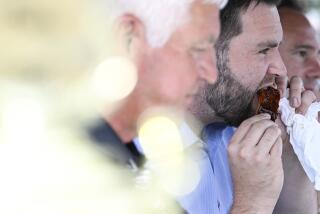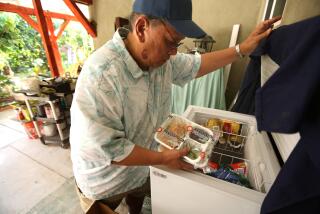No Free Lunch in the House; Senate Still Subsidized
- Share via
WASHINGTON — Now that Congressional lawmakers can no longer skip out on their Capitol lunch bills, the question arises: How good is the food anyway?
For many years the answer was: not so great.
Though the surroundings were elegant and the clientele high-powered, the food at the exclusive House of Representatives’ dining room was bland and unhealthful. It deserved culinary impeachment.
But even as the members had to swallow last month’s bitter publicity about $300,000 in unpaid bills, the food was becoming far more appealing. Lawmakers, who now must pay in cash or by credit card, rather than by check, have the consolation of power dining that is finally worth paying for--even if no one will ever confuse it with Spago or Citrus.
“If you wanted to eat something that wasn’t going to hurt you, there was nothing there,” says Rep. Anthony C. Beilenson (D-Los Angeles), a 15-year congressional veteran, “just high fat, almost no fresh vegetables except for salads--and they weren’t particularly tasty.”
Now, he says, at least, “They are trying. There is more variety.”
Unnoticed in the free-lunch flap was the House’s decision to oust Service America, which had run its food service since 1987, and operate the kitchen itself. Representatives, long unhappy about the uninspiring offerings, felt this was one term limit they could stomach.
As a result, since August the bipartisan menu has seen such innovations as a grilled chicken and pesto sandwich, spinach salad with strawberries and mandarin oranges and “Heart Smart Alternatives.” These may be common in many trendy restaurants, but for the hidebound House, it’s downright radical.
Prices have increased, but remain quite reasonable (items range from $1.25 to $12.50). The food itself is not directly subsidized, but the kitchen and dining room are rent-free. In contrast, the Senate dining room, which has a reputation for slightly better food, receives a $1.3 million taxpayer-funded subsidy.
Although members get priority seating, the dining room is open to the public when tables are available. Representatives frequently entertain constituent groups amid the royal blue upholstered walls, brass chandeliers and black-tie clad waiters and waitresses.
“The ambience is where the appeal is,” says Rep. Connie Morella (R-Md.).”Constituents like the proximity to power.”
Still, some lawmakers forswear any culinary liability. “I always warn my constituents that I am not responsible for any illness or pain that might result,” quips Rep. Robert G. Torricelli (D-N.J.).
Convenience has long been the dining room’s drawing card. Members hustling between floor votes, committee meetings and sessions with lobbyists or visitors from back home, prefer to drop in than to walk several blocks to one of the numerous Capitol Hill restaurants. And the dining room accommodates them by staying open as long as the House remains in session.
This is also a place where business and pleasure mix. And schmoozing freely crosses party lines. “Friendships go across the political spectrum,” says a Capitol Hill correspondent. “You don’t really see that except over common meals.”
The tradition of an eating facility for members of Congress is as old as the Capitol itself. In the 1840s, a tavern-type room was located just off the crypt under the rotunda. During the Civil War, vendors sold apples and other goods inside the Capitol. Segregated House and Senate dining rooms were created when separate chambers were build in the 1850s. The present House dining room was constructed when the Capitol extension was completed in 1962.
“The Capitol has always found a way to feed itself,” says House Historian Ray Smock.
But that doesn’t mean feeding itself well. A new executive chef, John Sailes, was recently hired to replace the “steam-table mentality” of the previous regime. “They used prepackaged frozen foods, which are more costly,” says Sailes, a former Cleveland restaurateur and 18-year caterer. “We are bringing in all fresh foods. And we are introducing regional specialties--Texas and Southern barbecues as well as Italian dishes for our Chicago members.”
The dining room was in full swing during two recent visits. The food was pleasant, or as Rep. Dana Rohrabacher (R-Long Beach) put it, “better than the cafeteria in high school.” The service was attentive and polite, and the newly decorated setting worthy of a four-star restaurant.
What to eat? The vegetable soup ($1.25) arrived lukewarm, but the vegetables were plentiful and fresh-tasting and the broth lightly seasoned. The guacamole ($2.75) was chunky and zesty, but the accompanying salsa was as thin as a one-vote victory margin.
The hearty sandwiches were served on fresh bread. The grilled chicken breast with pesto ($7.50) was served on a crusty French baguette. But the pasta primavera served on the side was tepid and gummy.
The three-cheese grill ($2.25) combined mozzarella, Cheddar and Monterey Jack cheese, and the grilled Reuben ($5.50) contained lean corned beef. Both were accompanied by thick crisp steak fries. Salads were uninteresting but were fresh and came with non-commercial dressings.
Daily specials included the “Heart Smart Alternative”--a skewered breast of chicken teriyaki ($7.95), which had a pasty texture from over-marination. There were also braised lamb shanks ($8.50) with a certain strength of character.
From the dessert tray, the chocolate decadence cake ($2.50) was not terribly corrupting, but the deep-dish pecan tart ($2) and the lemon cheesecake ($2.50) were excellent. Dieter Schorner, owner of the firm that supplies the fancy sweets, has made pastries for the Swedish royal family and was pastry chef at top New York restaurants. There is also good old American Jell-O on the menu.
One thing hasn’t changed: the much-touted Capitol bean soup. According to Congressional lore, House Speaker Joseph G. Cannon was infuriated to find the soup unavailable on an oppressively hot day in 1904. “Thunderation,” Cannon roared. “I had my mouth set for bean soup. From now on, hot or cold, rain, snow or shine, I want it on the menu every day!” Informed sources swear the soup was better years ago--before they had to clean the pots every day.
Indeed, the soup today is as tasteless as it is famous. Good luck finding the smoked ham hock listed in the recipe printed on the House menu.
Meanwhile, the Senate’s rival bean soup recipe, calls for “onions braised in butter.” But the Senate’s version is no better than the House’s--it tastes as canned as some Senators’ floor speeches.
“(The chefs on both sides of the floor) should try a new recipe,” Rep. Beilenson suggests. “Just because it’s old, doesn’t mean it’s good.”
More to Read
Get the L.A. Times Politics newsletter
Deeply reported insights into legislation, politics and policy from Sacramento, Washington and beyond. In your inbox three times per week.
You may occasionally receive promotional content from the Los Angeles Times.










